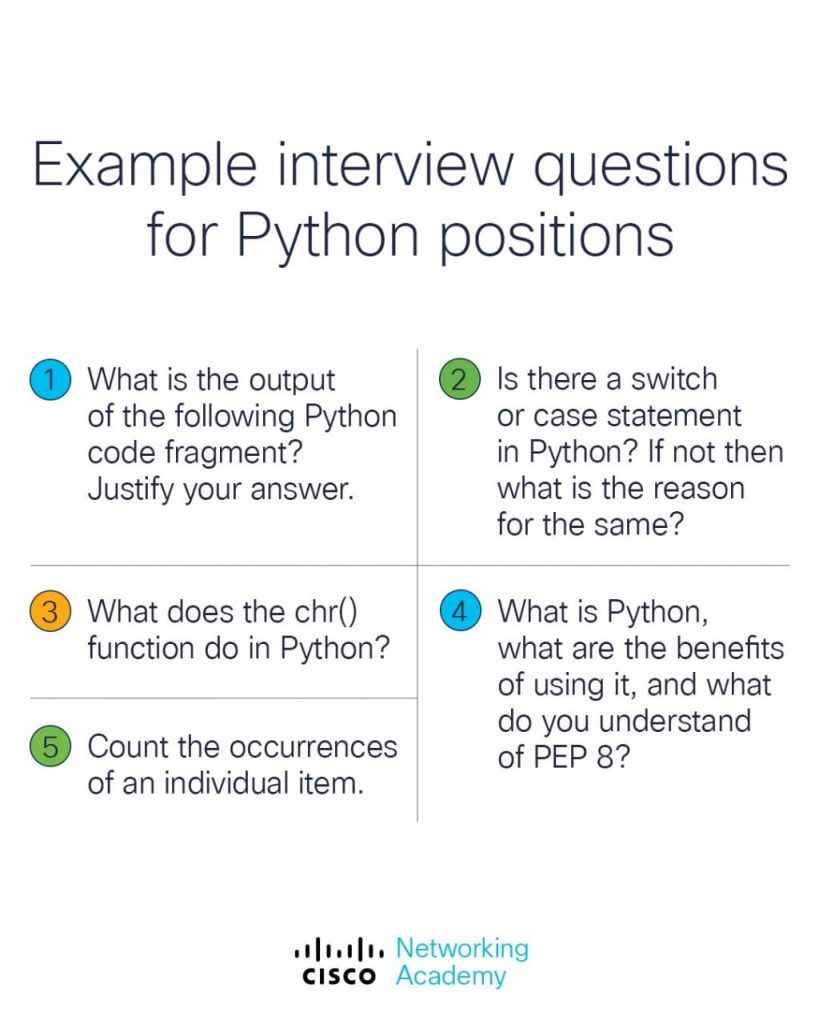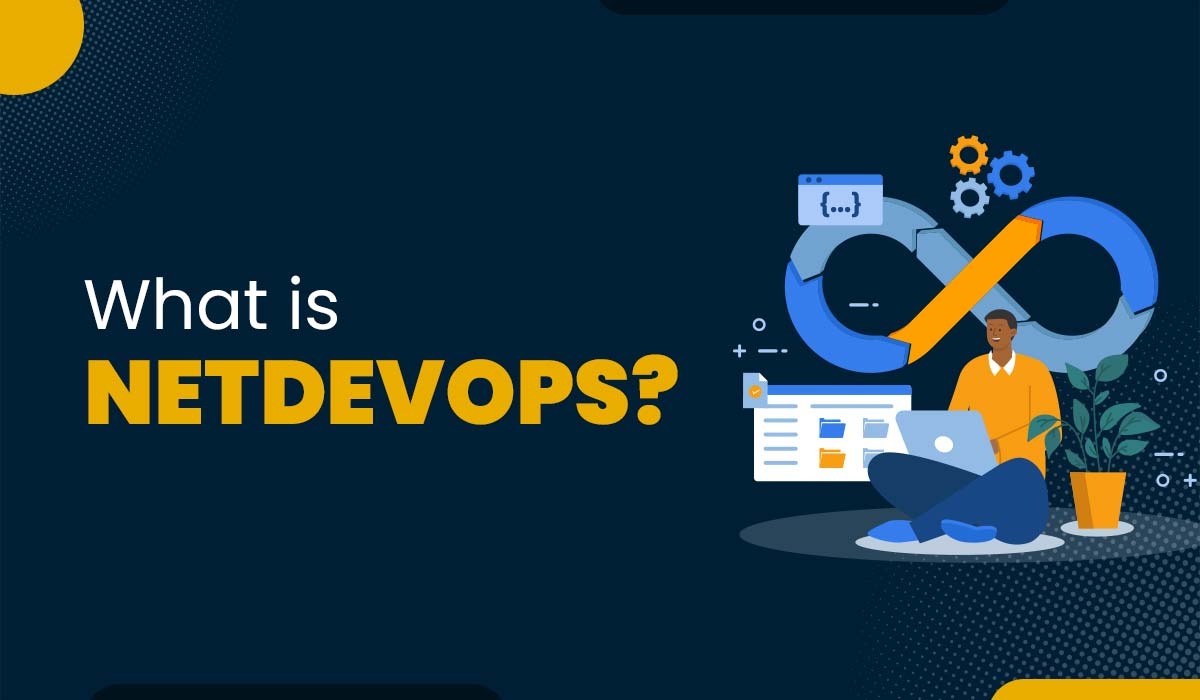Top 5 Python Interview Questions recommended by Cisco Networking Academy for Network Engineers

The Cisco Networking Academy have posted a list of 5 Python Interview Questions that are most common in any Python related interview. Cisco Networking Academy is a global initiative that equips people of all ages with the digital skills they need to succeed in today’s economy. They also design courses to allow network engineers to further their careers at any point in their career journey. The Cisco Networking Academy has been delivering education, technical training, and career mentoring to students in over 180 countries and has impacted the lives of over 10.9 million students. Cisco focused on changing the networking paradigm by adding a new course known as DevNet. With Cisco DevNet, network engineers can learn network automation with the help of programming and APIs easily. The DevNet track is focused on programming, and Python is the first choice of Cisco for network engineers since it is the easiest to learn and write and is the most used programming language. It is also a free and open-source language with straightforward and clean syntax making it easy for network engineers to learn Python. To help network engineers furthermore, Cisco Networking Academy shares many trendy things, and now they have shared these amazing 5 Python Interview Questions to help network automation engineers prepare for their next job interview. Here are the Top 5 Python Interview Questions recommended by Cisco Networking Academy – These interview questions are for anyone preparing for an interview for any job role that includes Python programming. Continue reading to find answers to these questions. In this article, we have discussed Cisco Networking Academy’s five essential questions with our specific answers that will assist you in getting unique solutions to face your next interview. Python is a high-level, interpreted programming language known for its simplicity and readability. It emphasizes code readability and encourages a clean and concise syntax, making it popular among beginners and experienced developers alike. Python’s extensive standard library and vast ecosystem of third-party packages make it versatile and suitable for various applications, such as web development, data analysis, machine learning, and automation. Python is a popular programming language for networking due to its simplicity and rich set of libraries. Python’s ease of use and readability make it ideal for tasks like network configuration, socket programming, network scanning, and building network applications. Its versatility and extensive community support make Python a go-to choice for network engineers and developers working on networking projects. Here are the 5 common Python interview questions to prepare you for the next Python interview and land your dream networking job. sampleList = [“”Jon””, “”Kelly””, “”Jessa””] sampleList.append(2, “”Scott””) print(sampleList)” Options – A – The program executed with errors B – [‘Jon’, ‘Kelly’, ‘Scott’, ‘Jessa’] C – [‘Jon’, ‘Kelly’, ‘Jessa’, ‘Scott’] D – [‘Jon’, ‘Scott’, ‘Kelly’, ‘Jessa’] The right answer to this question is Option A. Justification – Append doesn’t expect more than 1 argument. It is used for adding the element at the end of the list, and we cannot specify the position using the index number. Note – The following code is written by PyNet Labs’ Python expert, not Cisco Networking Academy. We aim to give you an idea of what type of question you can get; there are chances that you might get something much more difficult. So, practice every scenario rigorously. Due to Unsatisfactory Proposals, Python lacks a switch/case statement. As yet, no one has proposed a solution that is compatible with Python’s syntax and standard coding practices. For lack of better mapping constructs, most programming languages rely on switch/case. They need it since it is impossible to assign a value to a function. In Python, though, you can simply use a mapping table (dict) to store how each item corresponds to a predefined operation. Chr() is used to find out the characters that are used to represent the specified Unicode. For example – >>> Chr(1) ‘\x01’ Python is widely recognized as a leading programming language with rapid adoption and popularity. In addition to being a general-purpose language, it is also a high-level, interpreted, object-oriented scripting language. Python is one of several languages available in today’s information technology industry, but it has grown very popular for the following reasons: Python Enterprise Proposal is an acronym for PEP. The Python Coding Standards (PEP 8) is a document that contains advice on how to make Python code more readable. The PEP 8 standard explains to the programmer how to create aesthetically pleasing programs. The primary goal of PEP is to improve the code’s readability and uniformity. You can use the <list_name>.count(<item>) method of list class to count how often an item appears in a given list. These are the top 5 Python Interview Questions that one should have knowledge of before going to any interview. You may also like – If you have the right mix of curiosity, drive, creativity, and logic, a career as a Network Automation Engineer offers a wealth of opportunities. Python is a great language to pick up if you fit that description. To learn Python for Network Engineers, anyone can take PyNet Labs’ CCNA DevNet course and advance their careers by acquiring the most in-demand skills of the present and future since this training begins with Python from scratch. The ability to create new possibilities is a way to increase your professional standing, increasing your chances of landing a high-paying job. PyNet Labs is the most trusted Cisco partner because we provide the optimal balance of job-oriented training created by Industry Experts to help you gain expertise, become certified, and provide your company with world-class Cisco Solutions.Introduction

About Python
Top 5 Python Interview Questions
Q1 – What is the output of the following code?
Q2 – Is there a switch or case statement in Python? If not, then what is the reason for the same?
Q3 – What does the Chr() function do in Python?
Q4 – What is Python, what are the benefits of using it, and what do you understand of PEP8?
Q5 – How to Count the occurrences of an individual item?
Network Automation Tools
Start Network Automation JourneyConclusion







